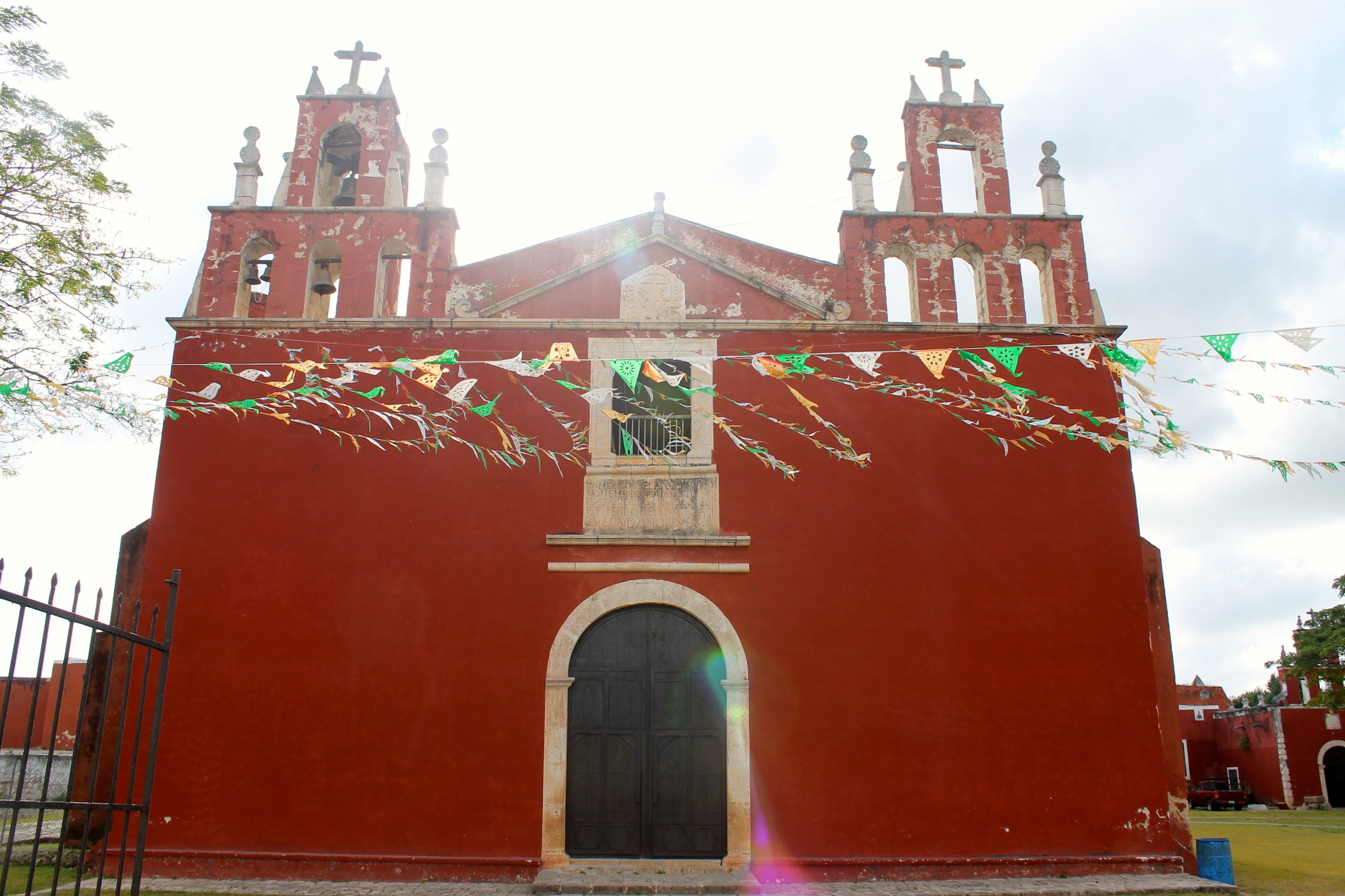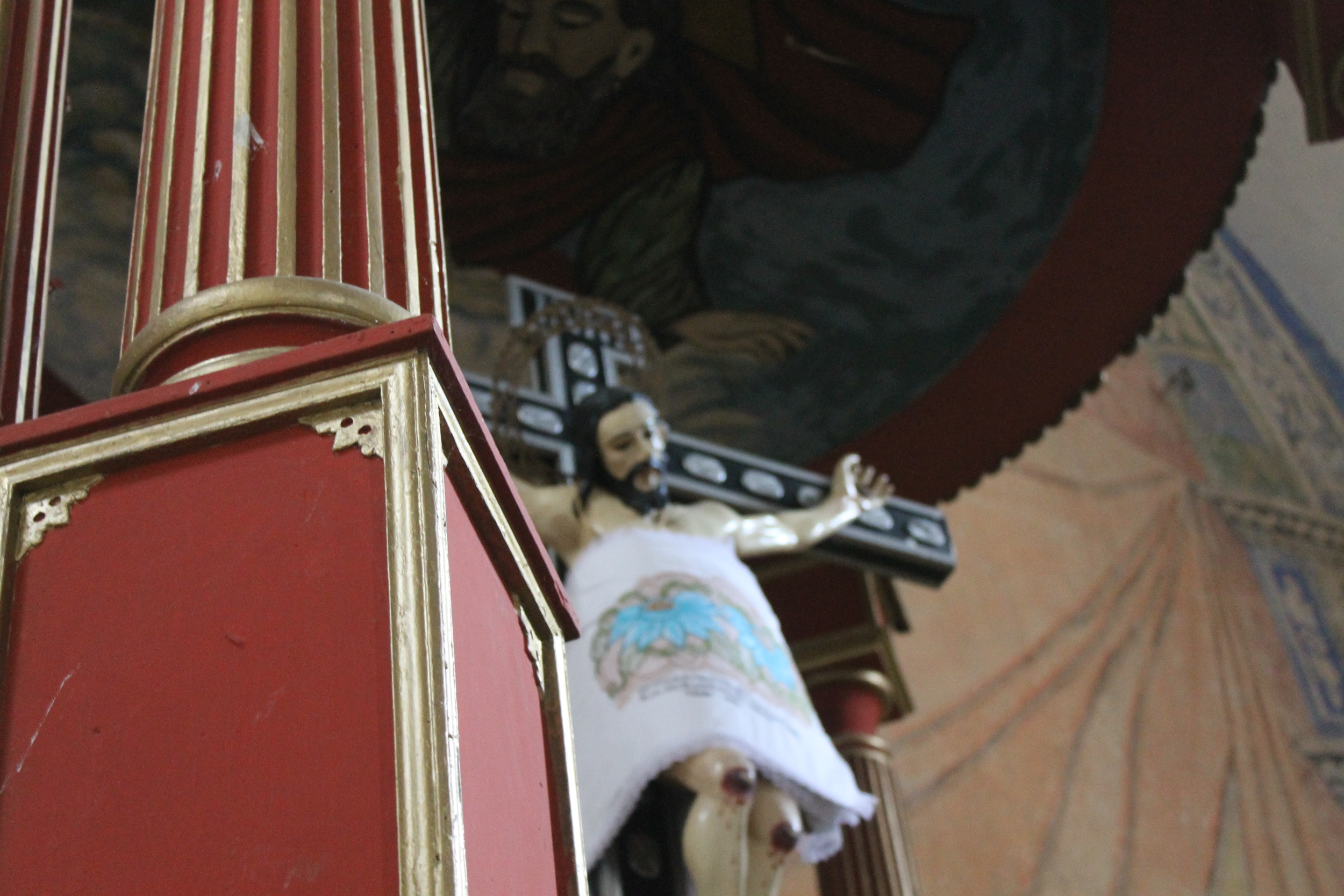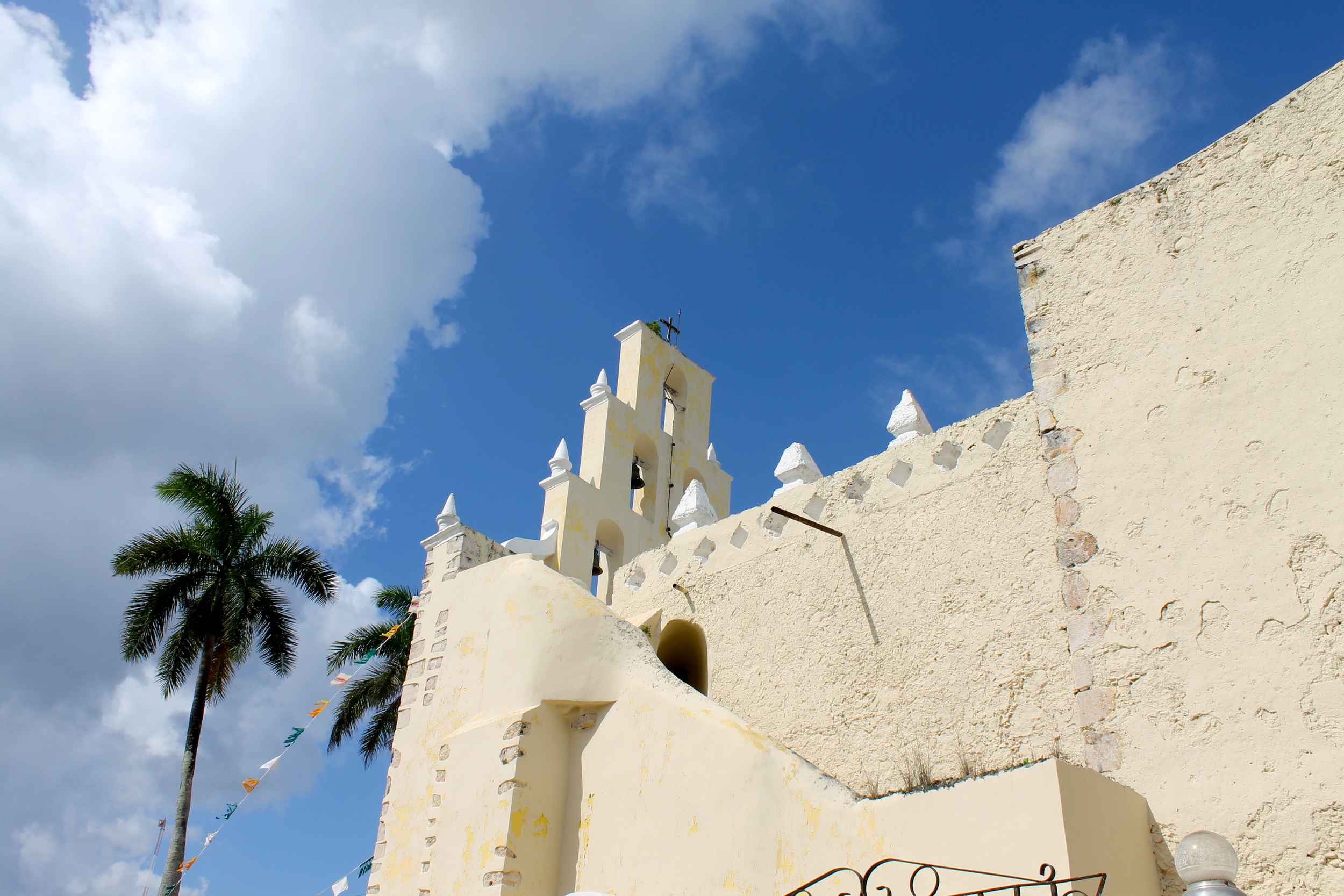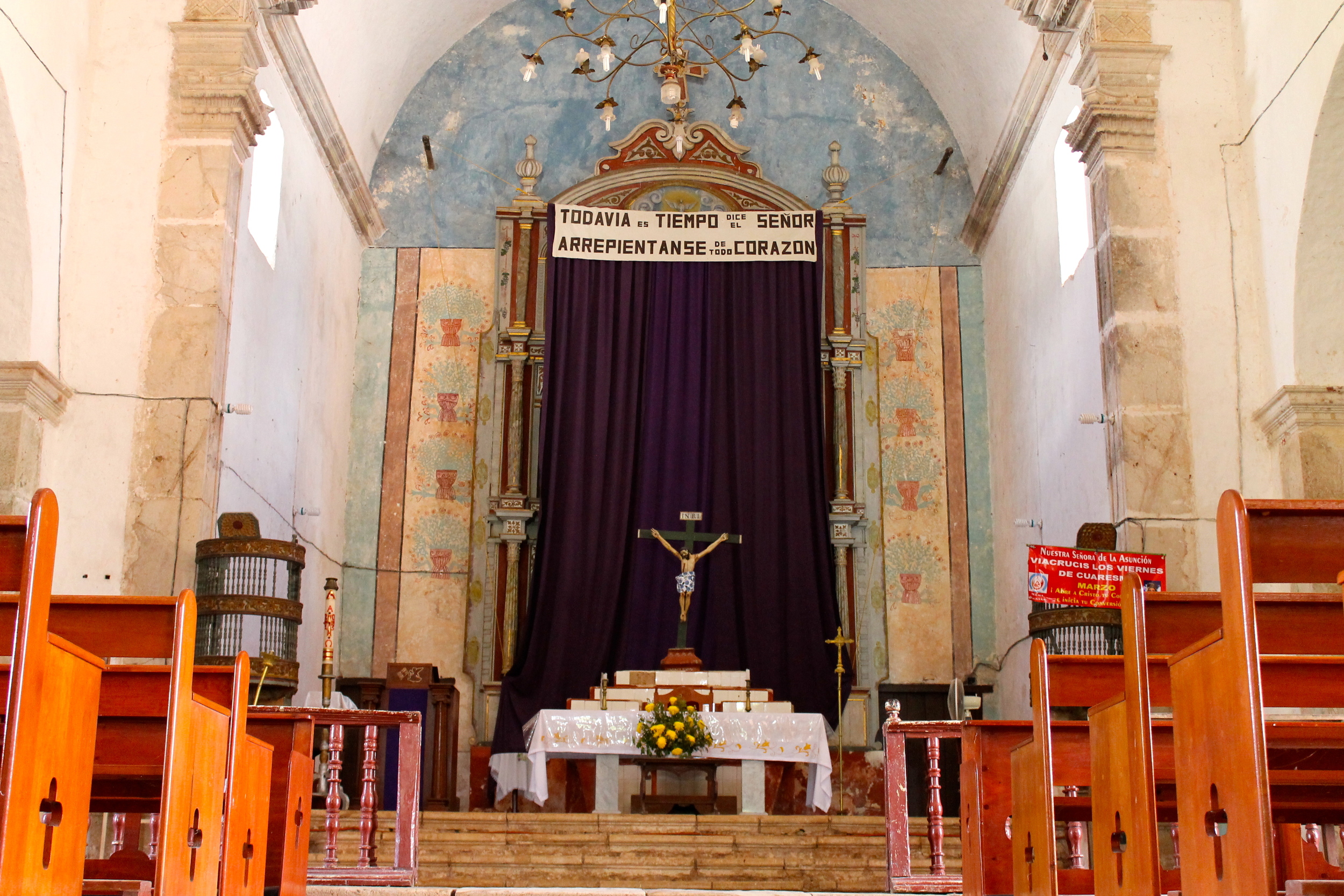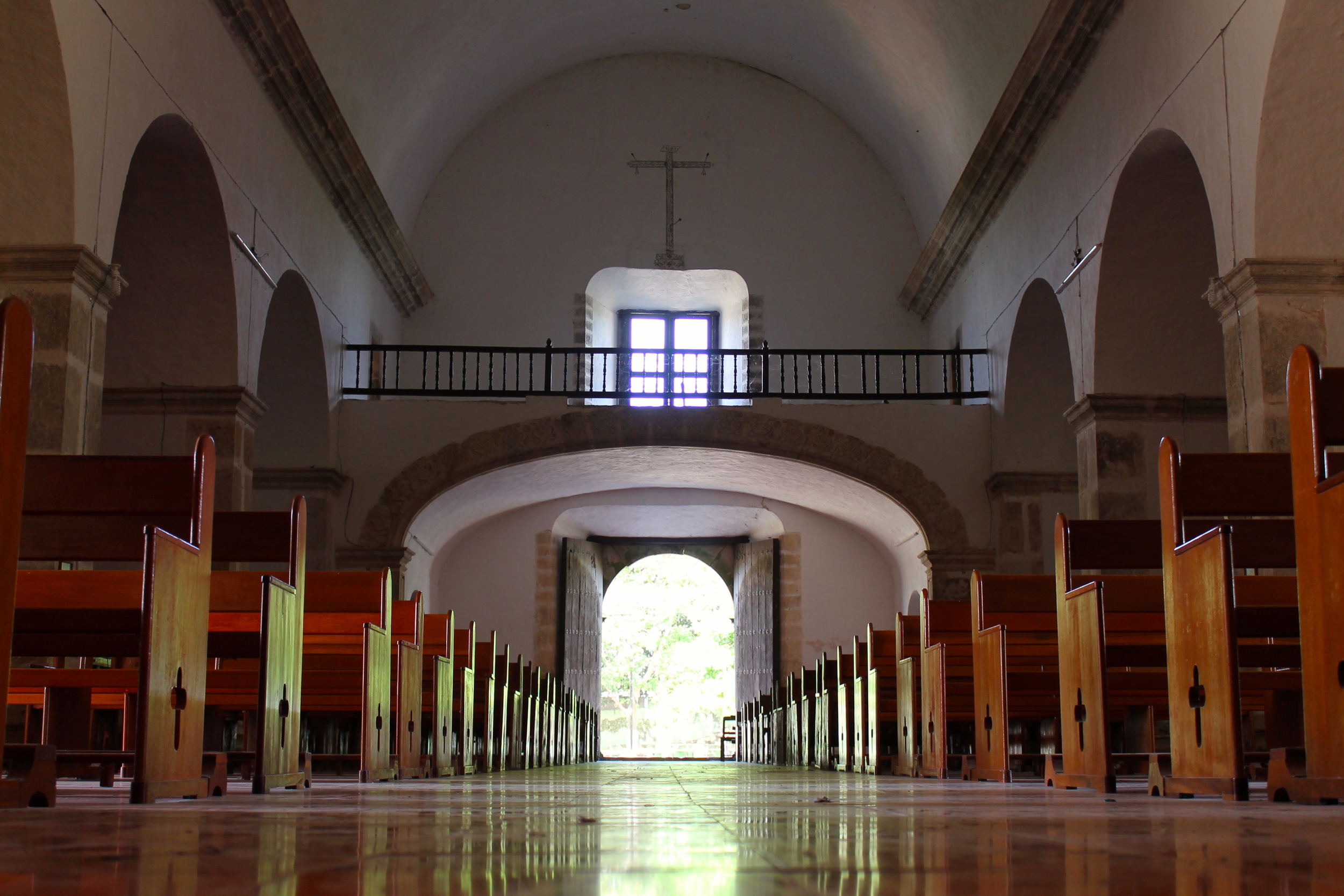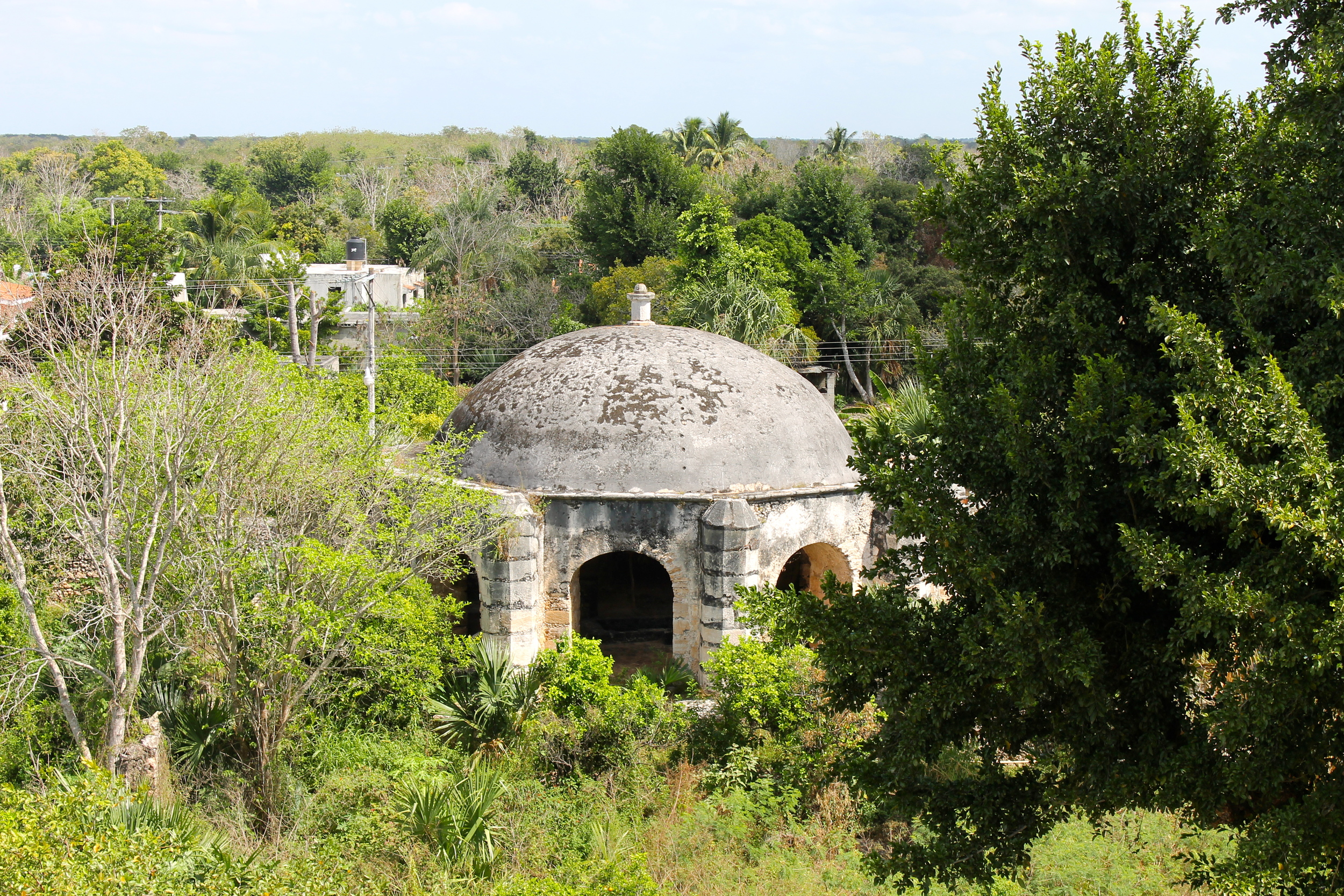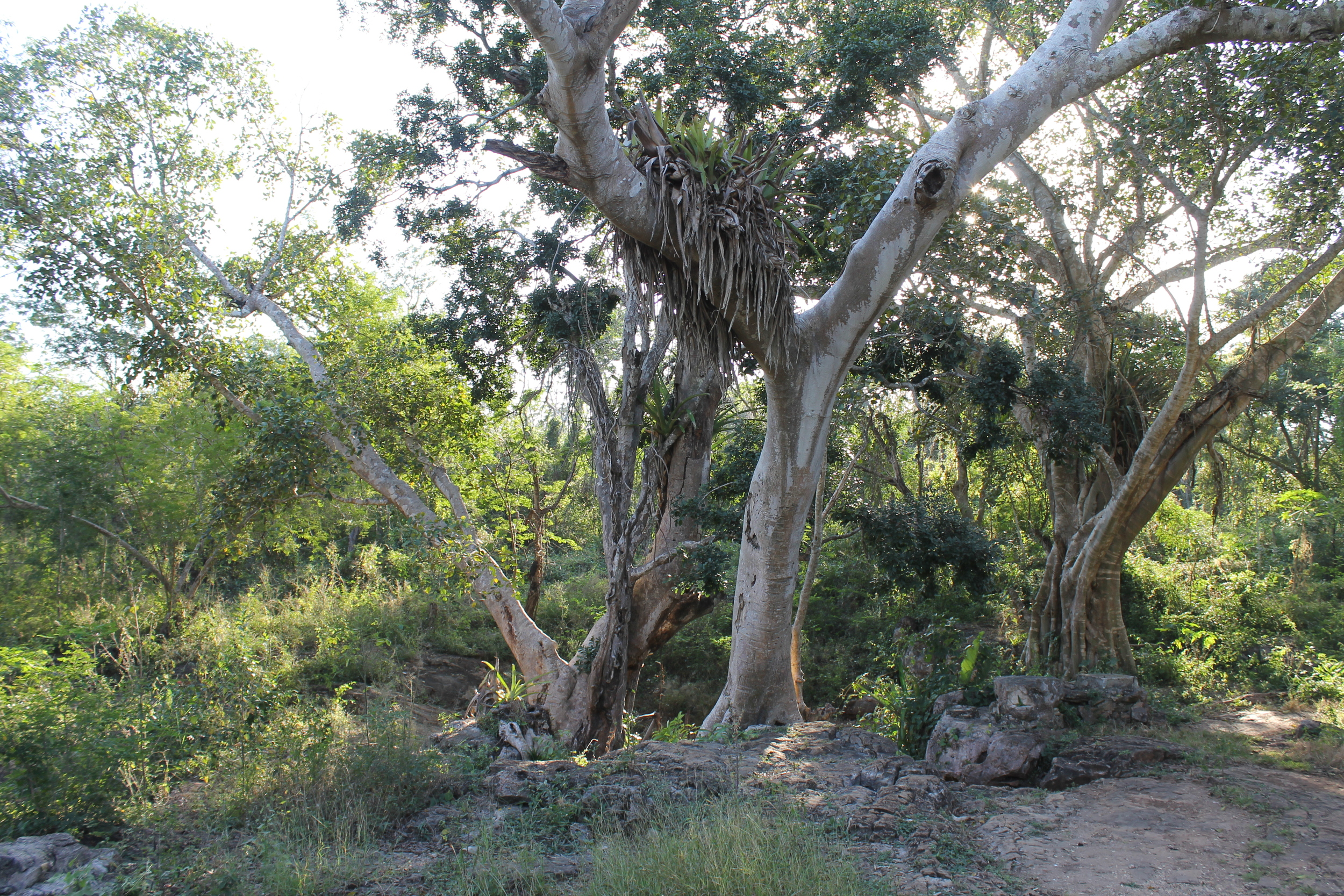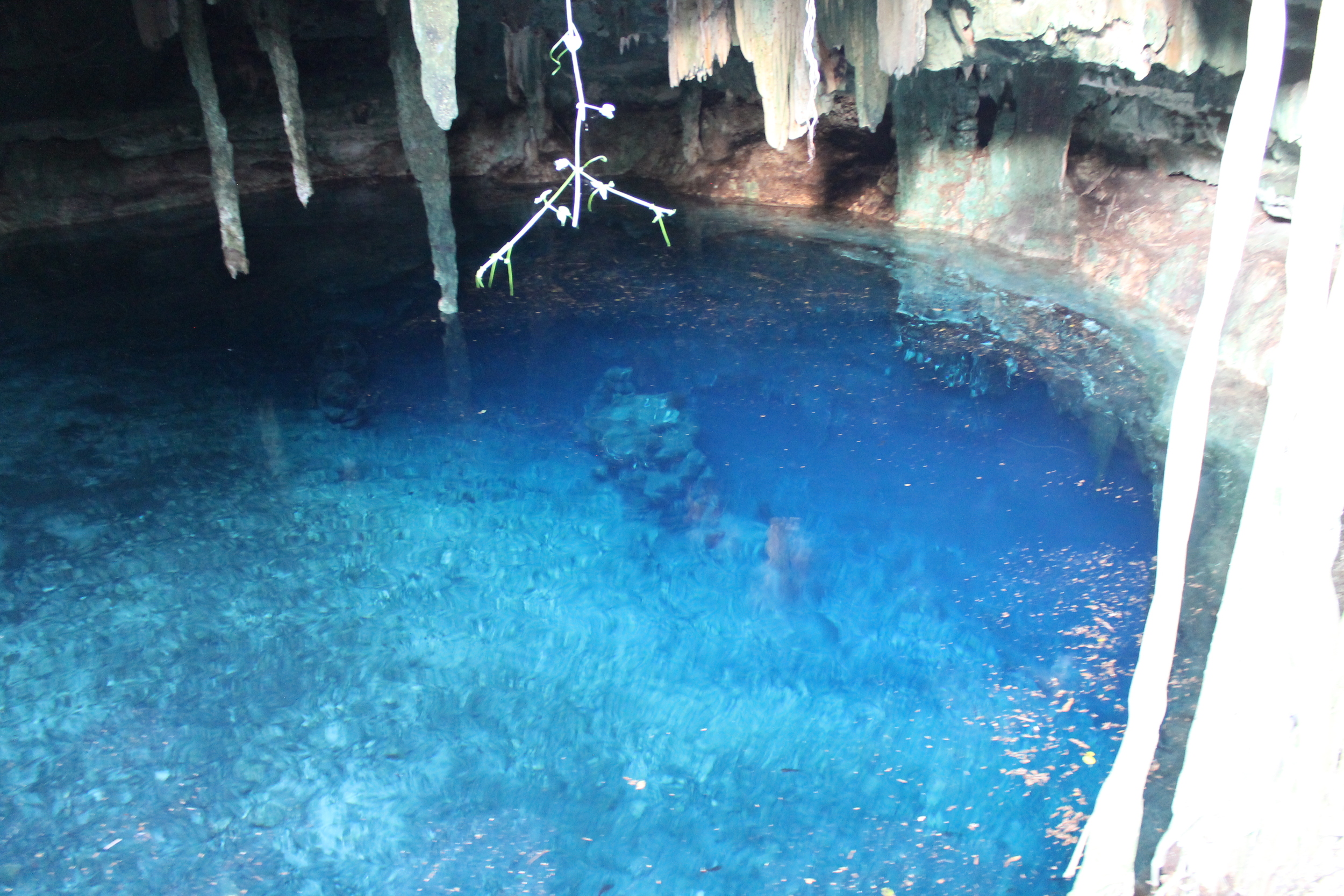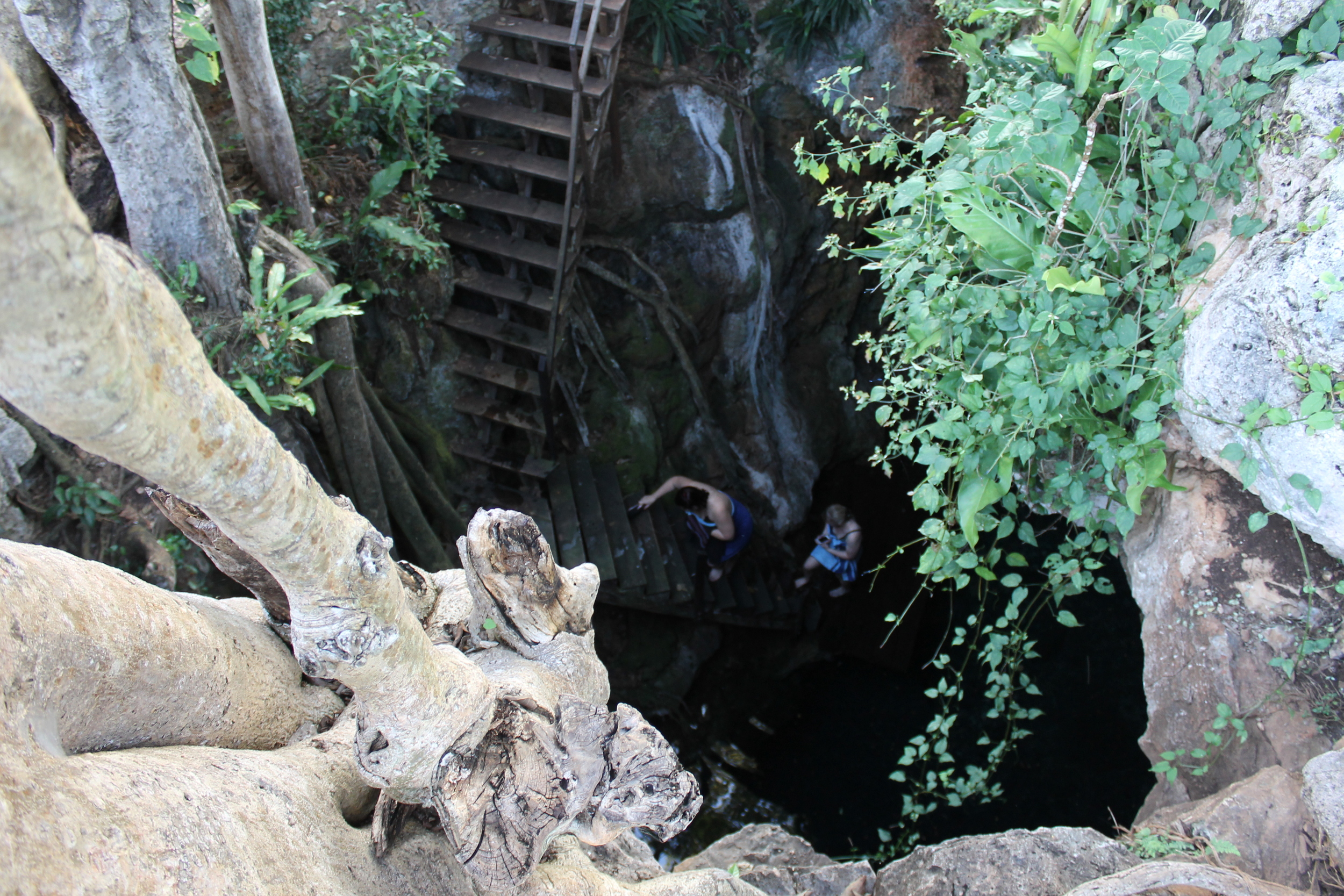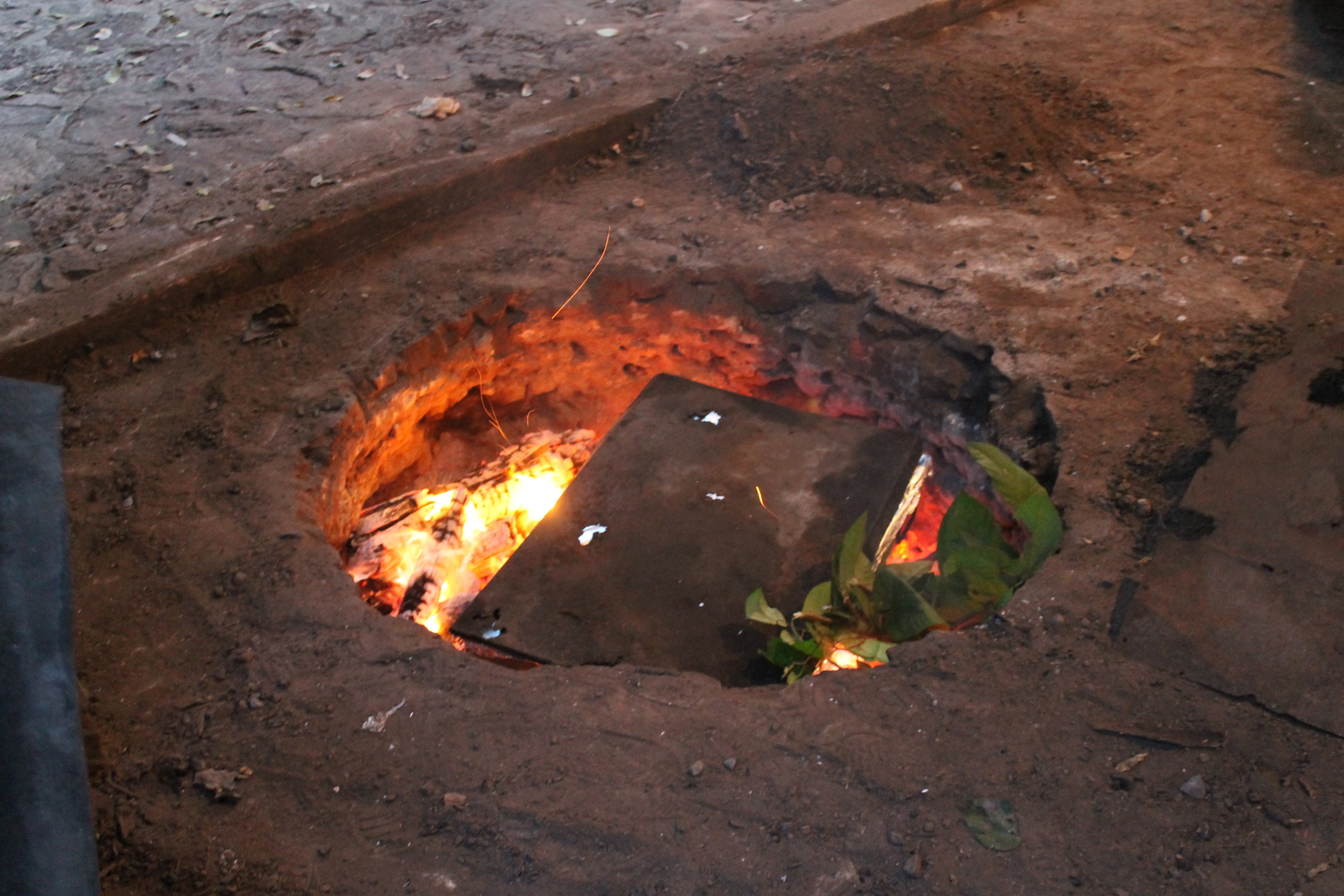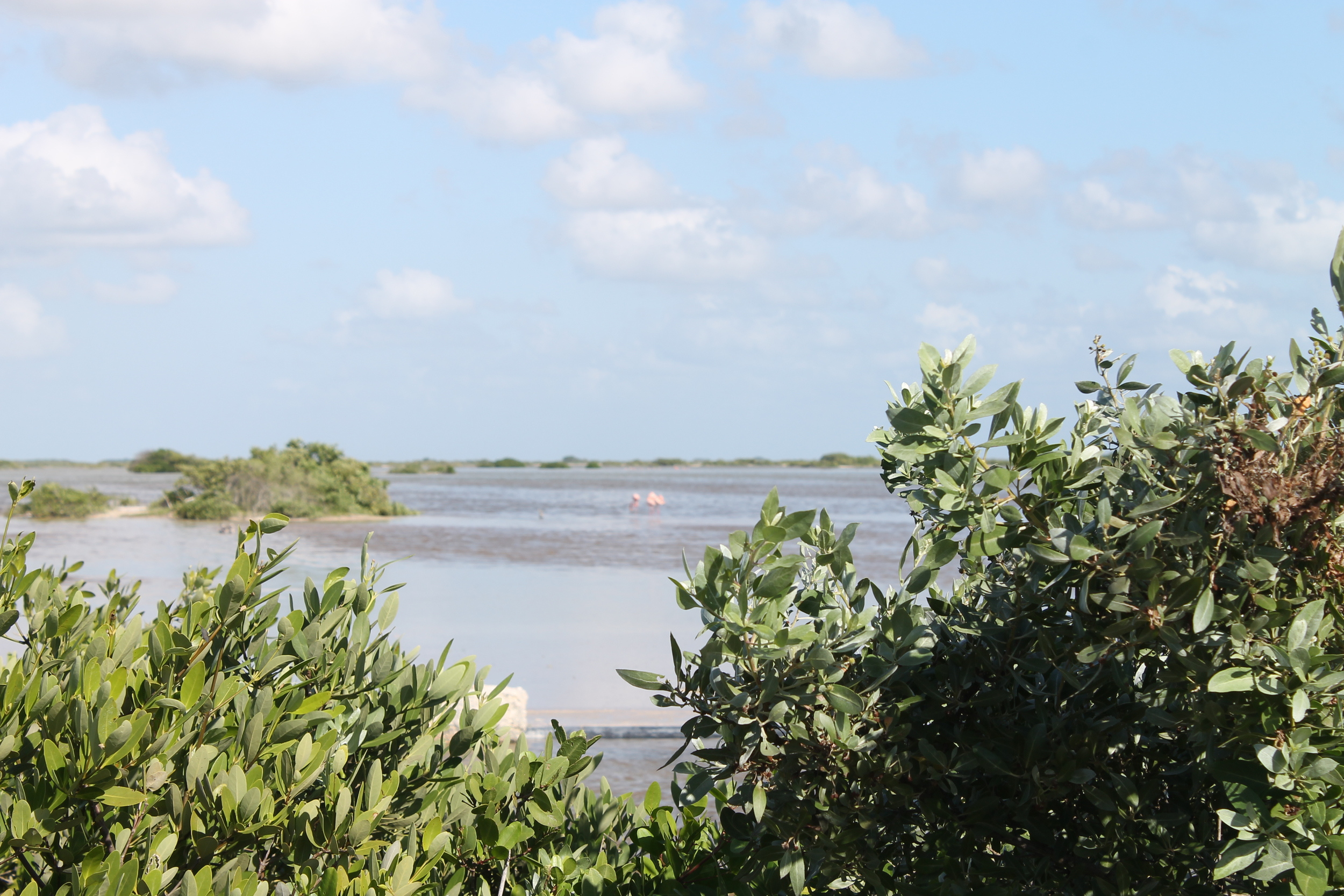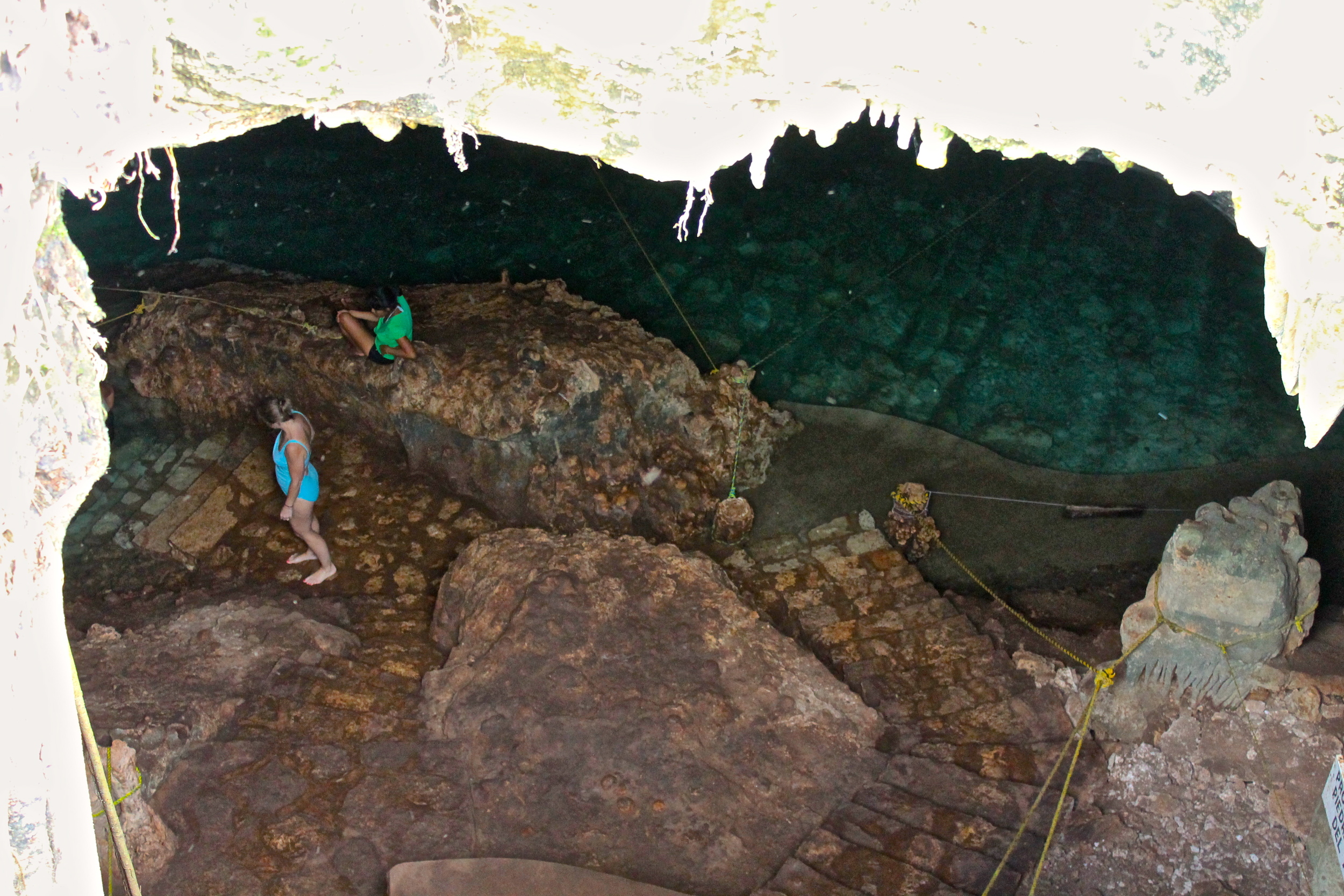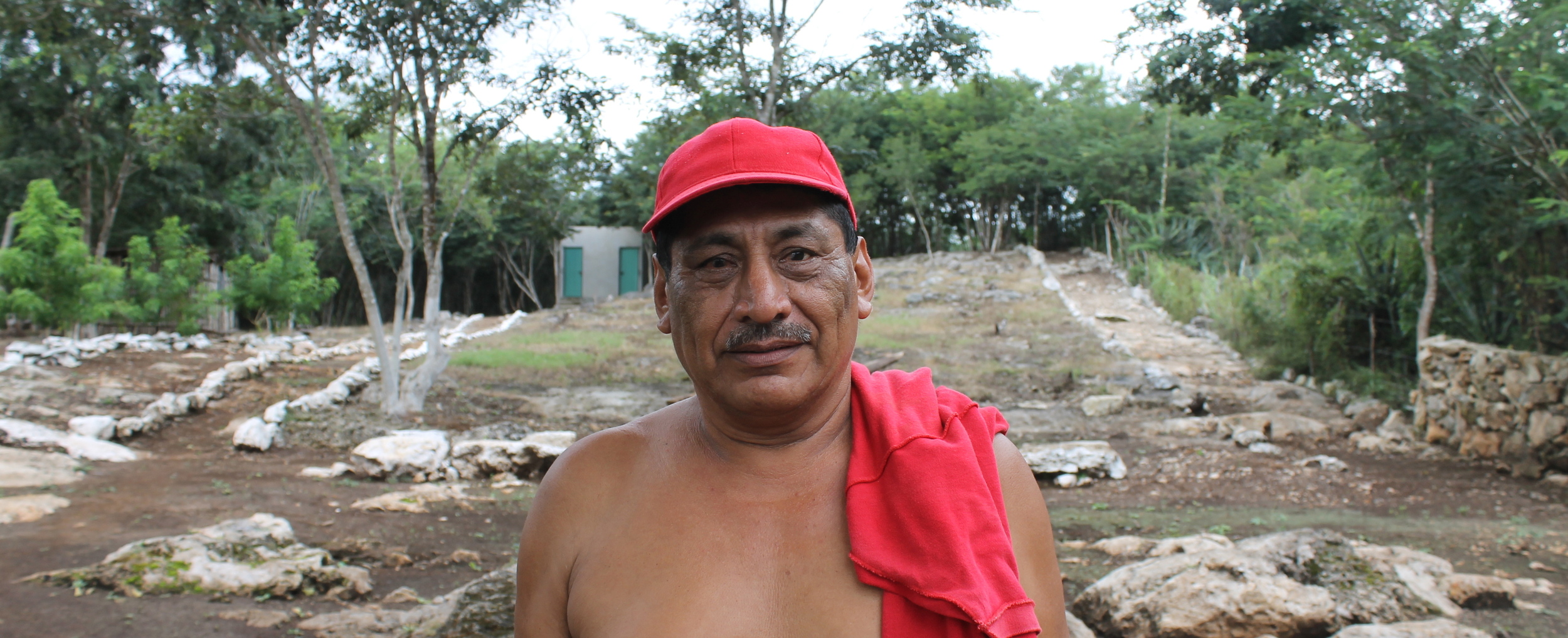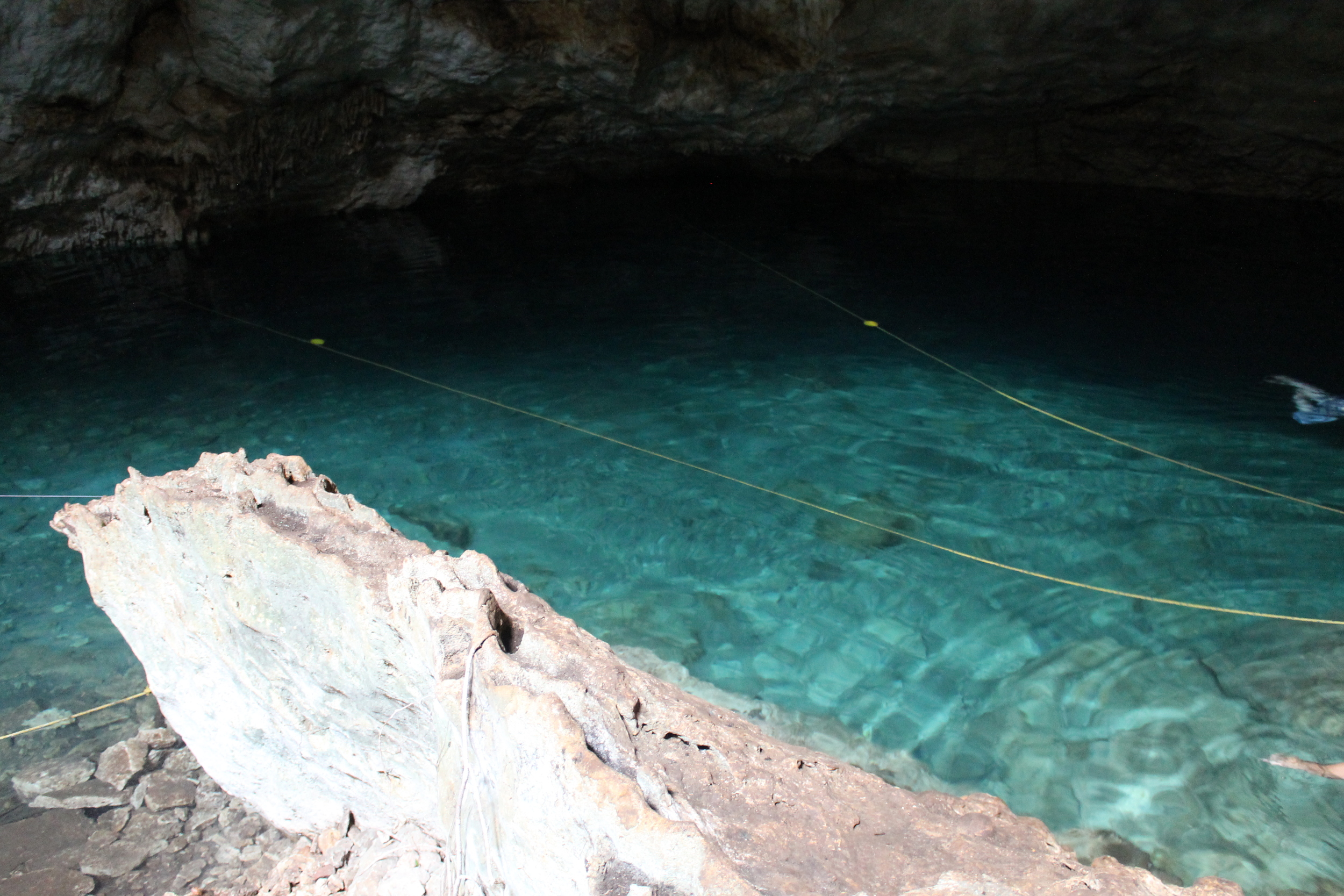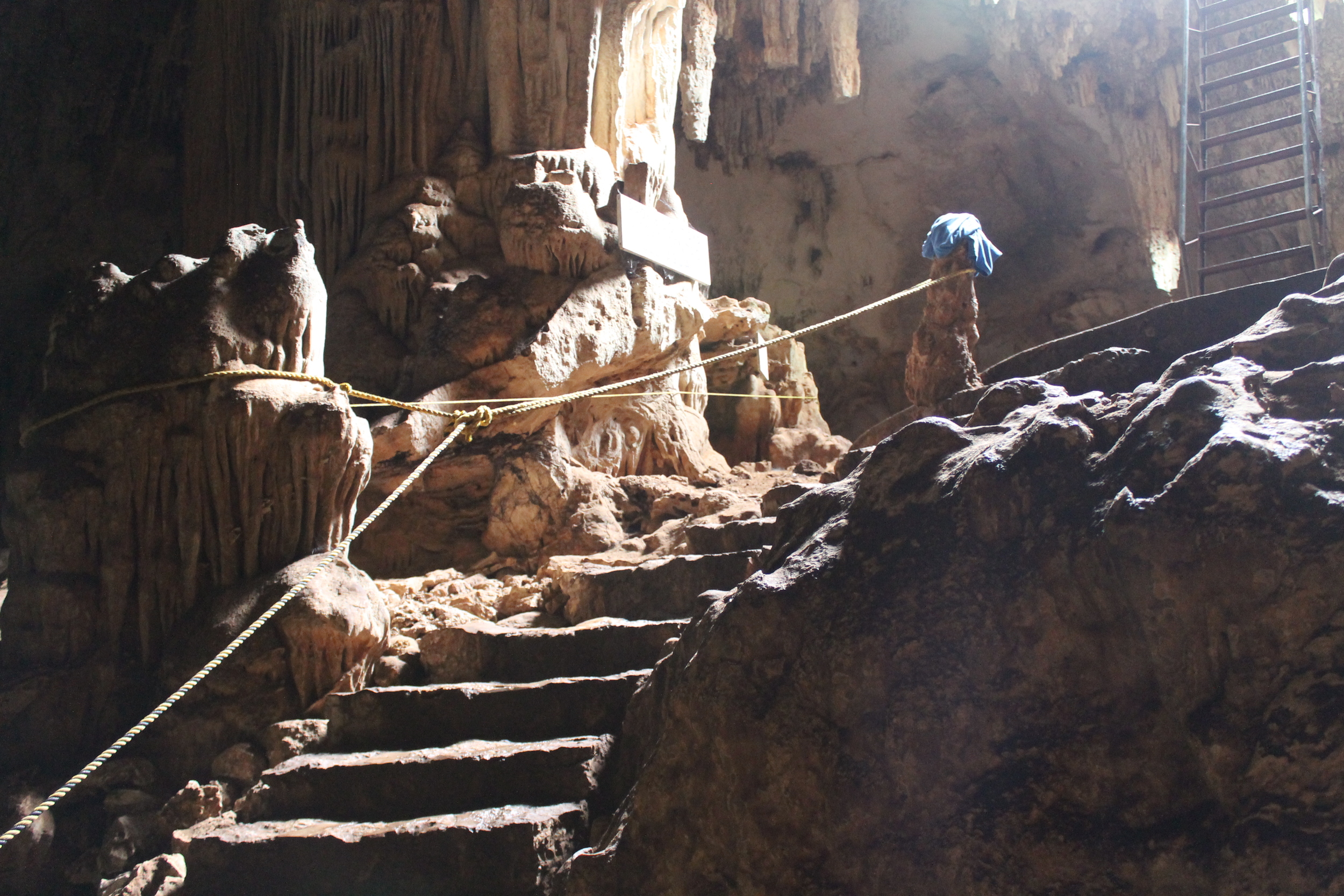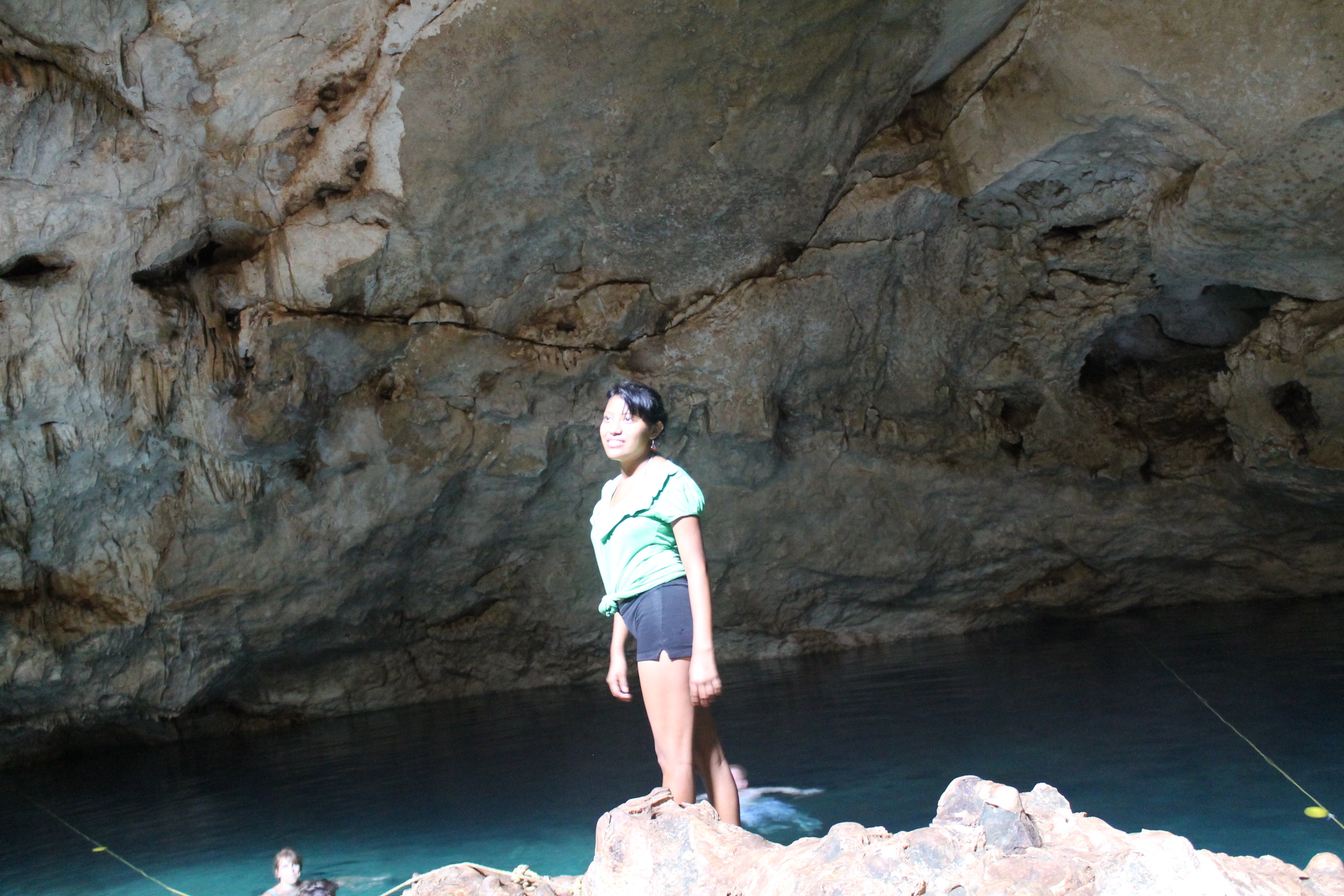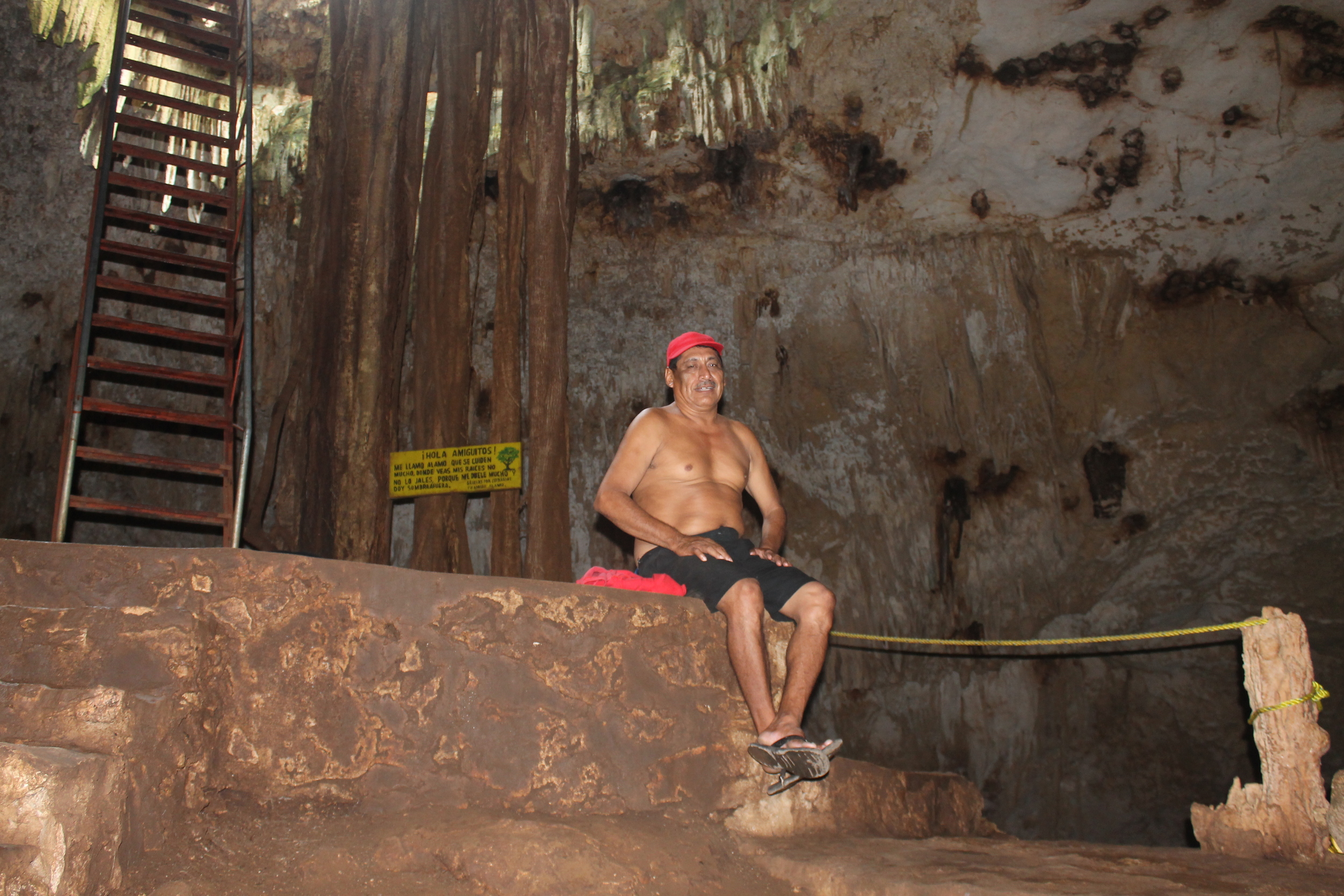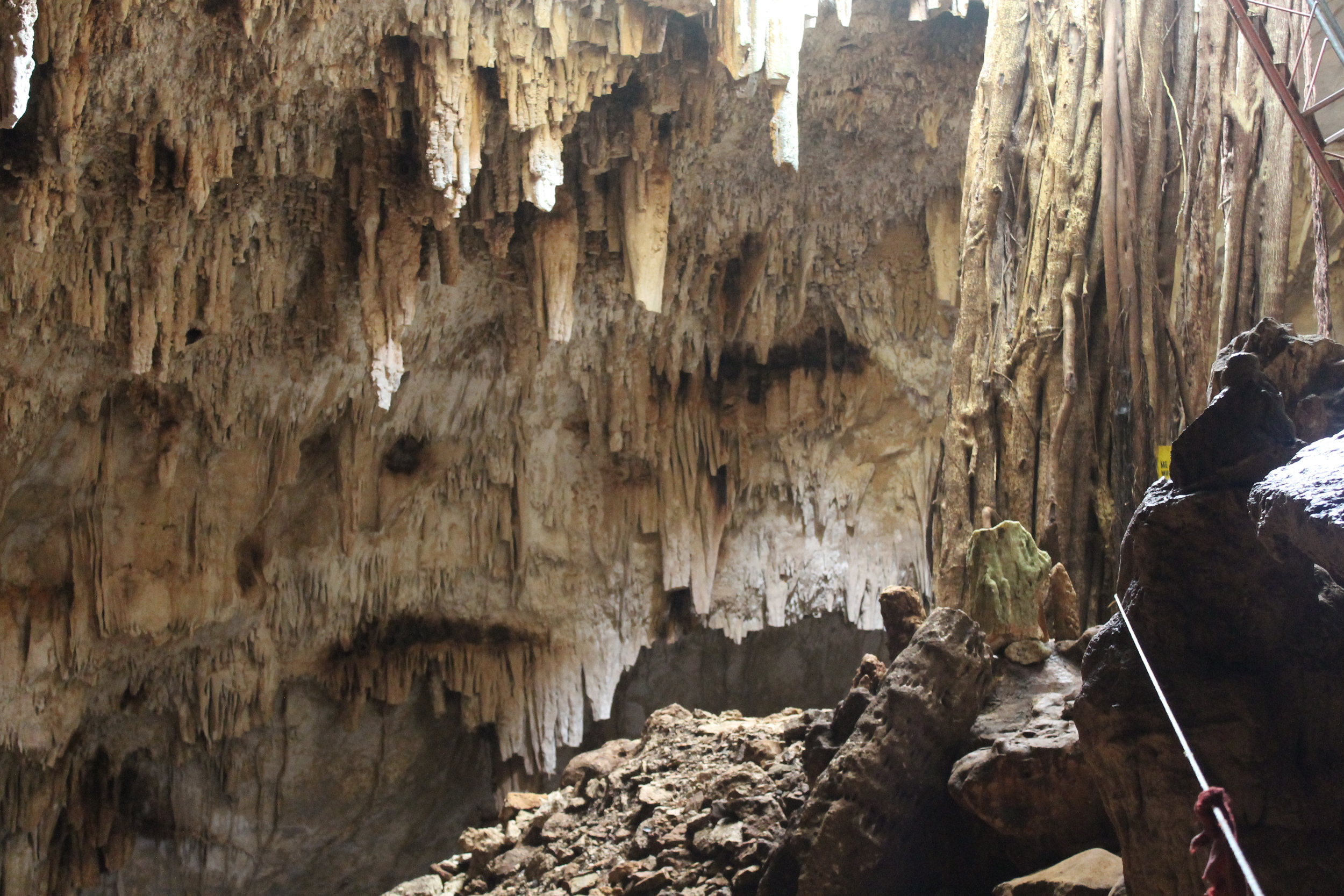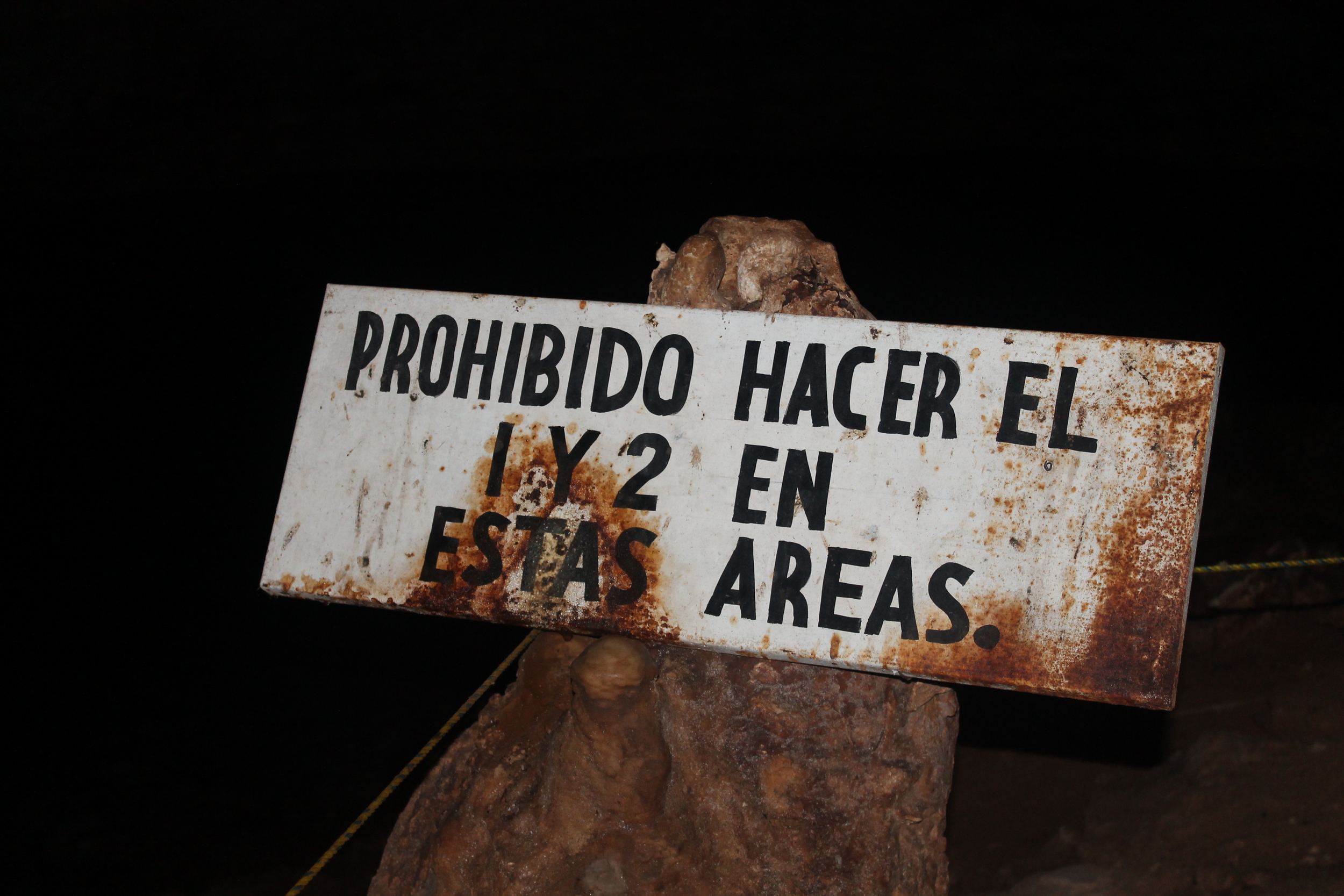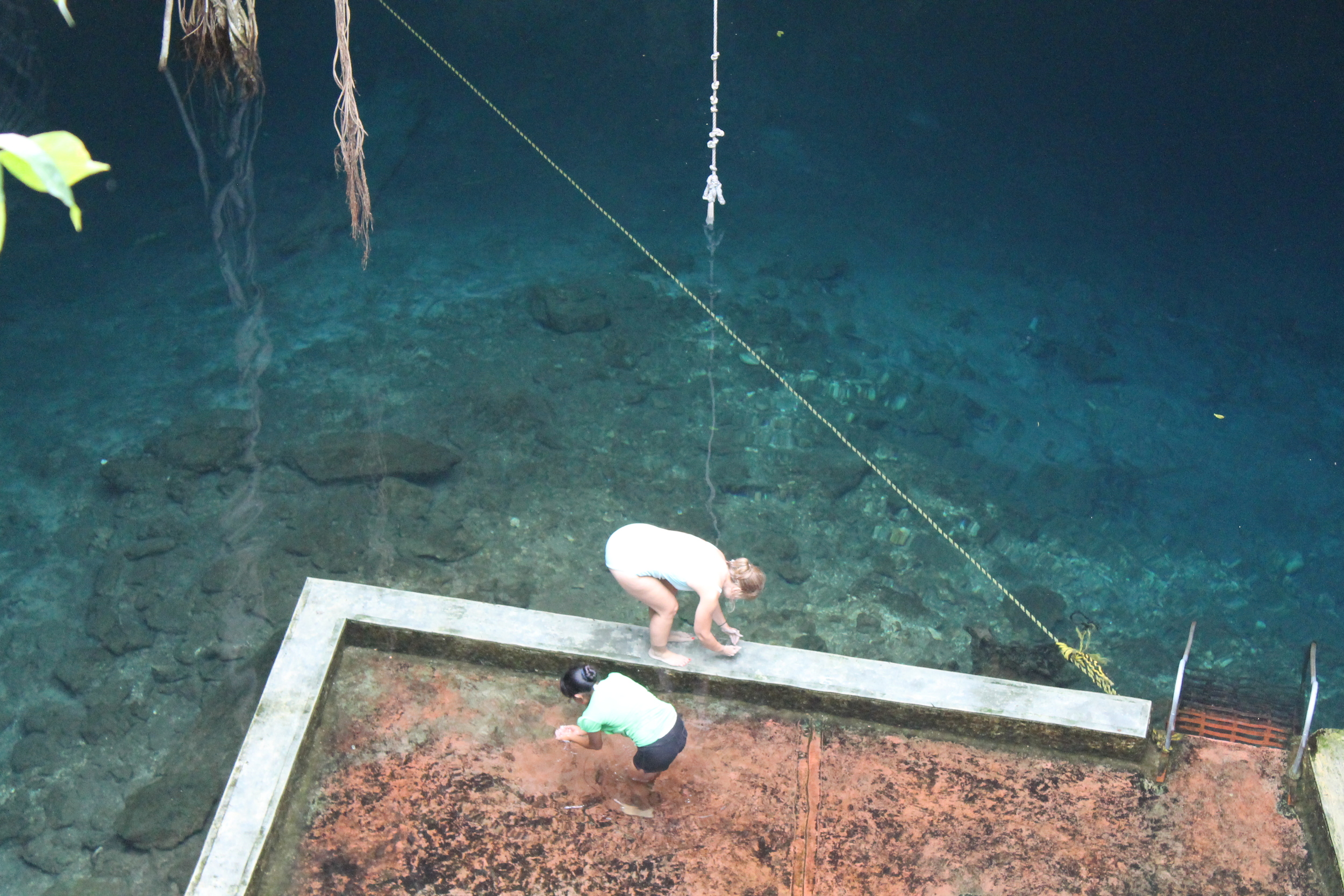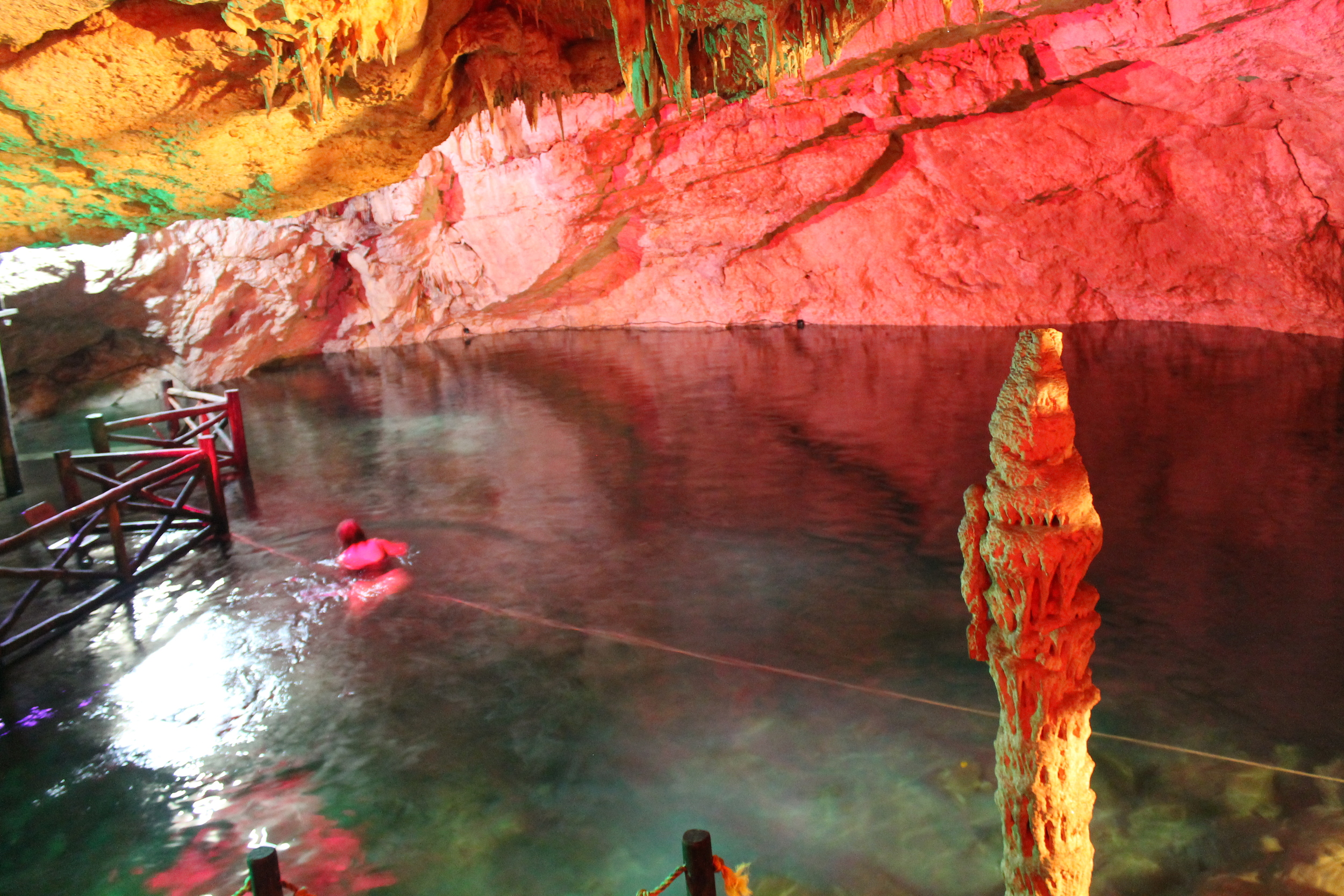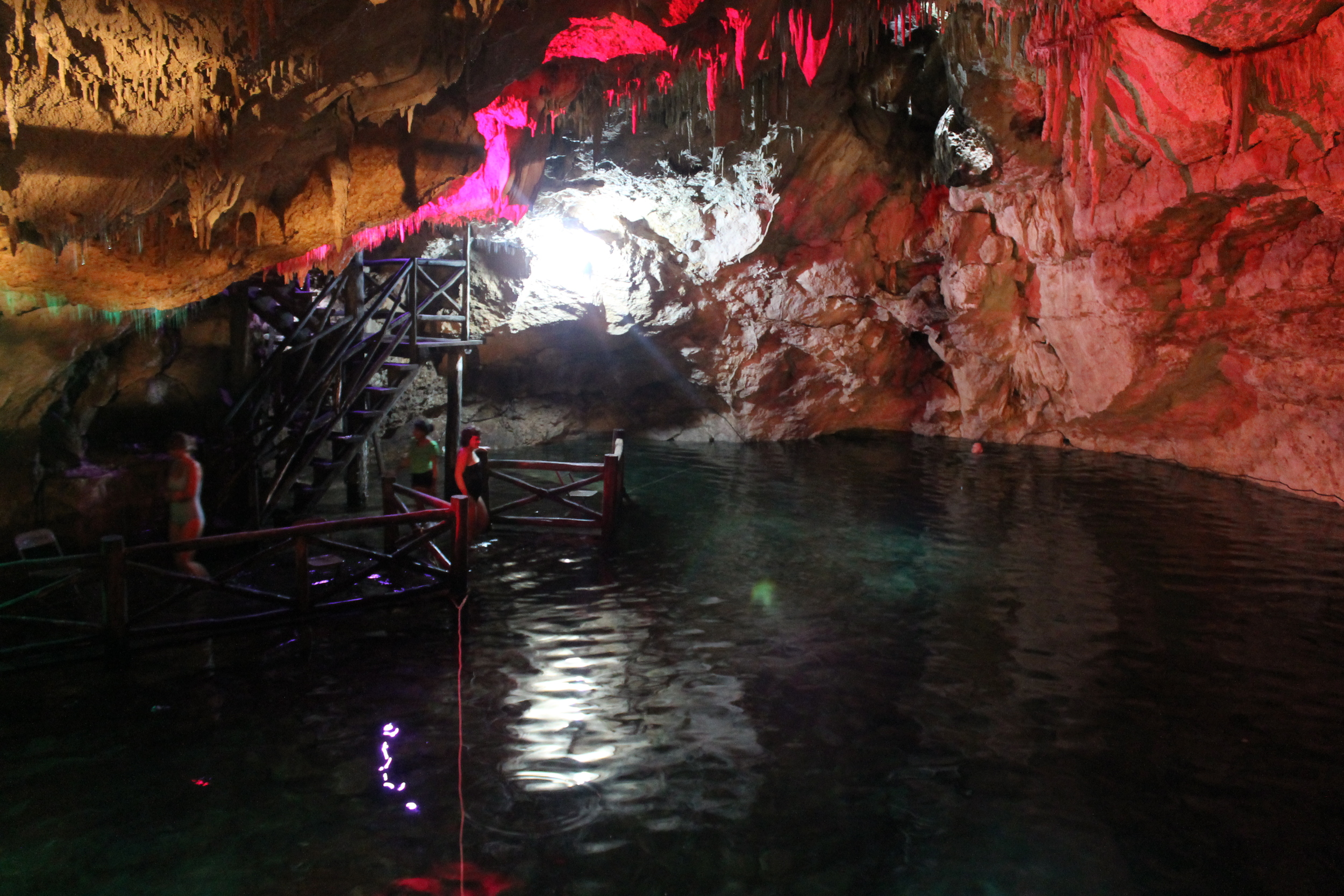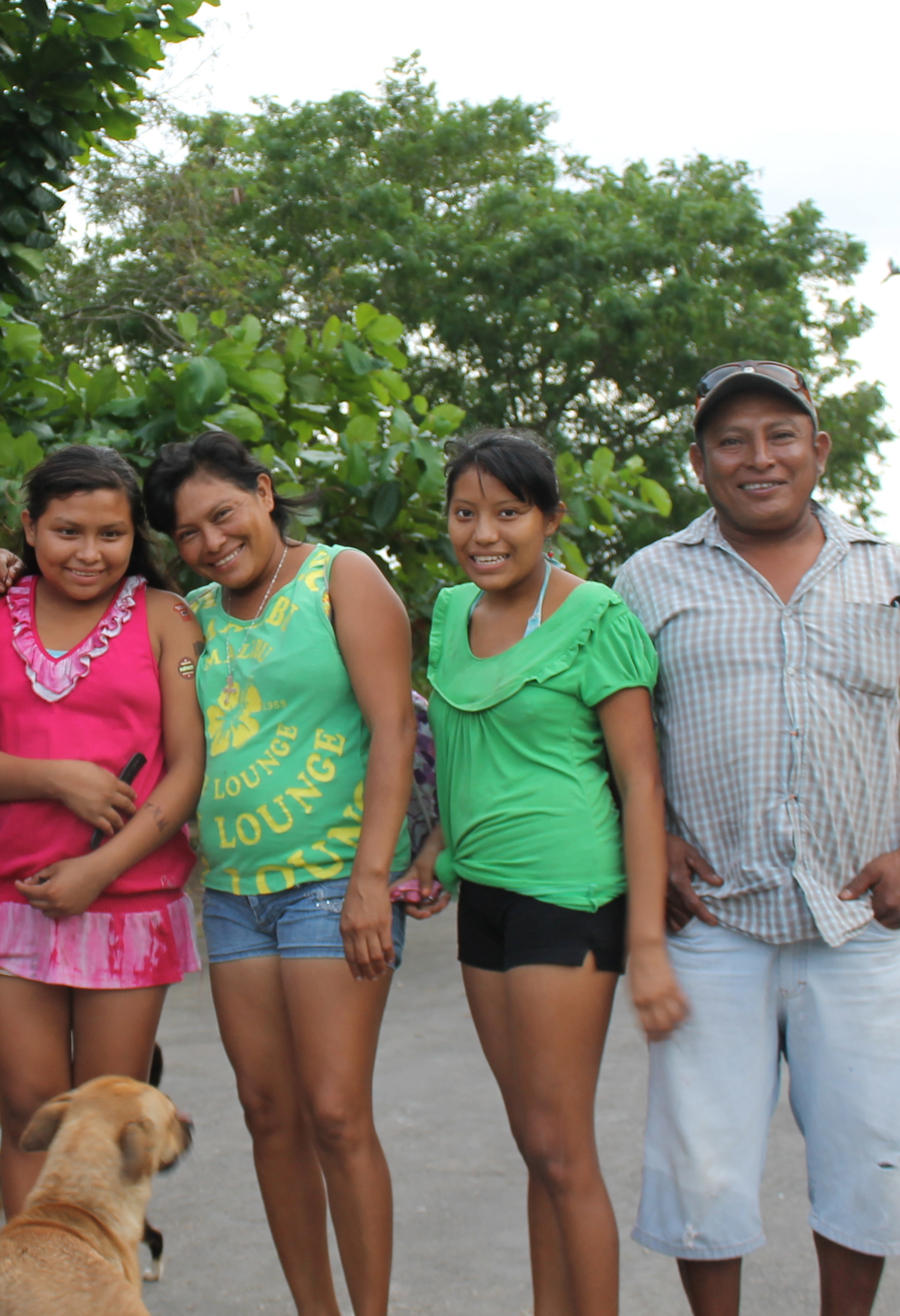Near Sotuta and Cantamayec, in the heart of the Mayan hinterland, are many hidden cenotes.
The Convent Route - Day One
Wooden cross in stucco on a church wall in Mama (that's the name of the town, really)
One of the routes that is promoted among tourism organizations is the so-called Convent Route or Ruta de los Conventos. I refer to it as "so-called" as it is really just a list of towns that have churches in them, dating back to the 1600's and that are full of history, but there is no real coordination of the touristic kind and if you arrive after the last morning mass, you are out of luck. No convent for you!
So, to do it right, you have to get up early. Our intrepid little group of three left Merida at the ungodly (no pun intended) hour of 7 AM and found that that is the perfect time to visit at least 4-5 of the churches on the route before they close for the day.
First stop? The furthest point of the day's travel: Teabo. Teabo sounds like what you say when you love someone, in Spanish, and have a cold. Te amo. Teabo. Get it? The photos will speak for themselves; a very picturesque little church that was closed but a little chat with the gardeners trimming the grass outside and they found someone with a key and it was opened just for us.
After we had our fill of Teabo and purchased some fresh tortillas at the tortilleria for breakfast, we moved along to our next stop, Chumayel, famous for its black Christ figure which was saved by a local villager named Severo who hid the wooden statue in his home when Salvador Alvarado's troops came to town with orders to burn the insides of the church. Salvador Alvarado was determined to break the church which had far too much power for the politicians of the day and ransacking and burning churches seemed like a good way to go about it.
Next stop: Mama. That's "no, no" in Mayan unless someone tells you otherwise. Then, you let ME know what it means. Mama in Spanish of course means female breast (where do you think mammary comes from) and if you add an accent ie. Mamá, then you have Mom. But I digress. Enjoy the photos of Mama's church, one of the larger churches of the day, so far. By the way, if you are on this tour, you might be feeling the urge to visit a bathroom at this point - feel free to use the bathroom at the municipal hall across the street.
Just at the entrance to Chumayel is a very colorful and photogenic cemetery that's worth a stop. So stop we did.
Tekit was the next stop on the day's tour, making it church number 4, and miraculously none of the churches were closed up to this point! Note that there are a lot of towns in the Yucatan that begin with the prefix "Te" (Tekit, Tekik, Tecoh, Tekax, Temozon, etc. etc.) and that is because the word "te" means something along the lines of "place of". Temozon, for example is Te = place of and Mozon = whirlwind. Anyway. Back to Tekit (no idea what a kit is).
The church itself is fine, a little run down compared to the others. The town looks like it has some money, but it is pretty sad looking. The mangy and hairless dog in the main square, standing dejectedly and in obvious pain waiting for some kind of relief, the dusty streets, graffiti next to the Jesus statue in the church; everything looks run down. Compared with a place like nearby Tecoh, where the residents seem to have some pride in their town and it shows, Tekit looks like no one cares.
Now the sun was shining in earnest and so we stopped for lunch at the Nah Luum hotel and restaurant, just across the street from the Tecoh exit off the highway and I was pleasantly surprised to find not only an attractive little restaurant and hotel, but smiling, gracious servers and good food!
Then, a small backtrack to a refreshing cenote on the way before returning to Merida - tired but satisfied with the day's achievements.
Uxmal, again. It never disappoints!
Uxmal is probably the most popular destination for day trips from Merida, for cruisers and non-cruisers alike. The great thing about Uxmal is that besides being the best Mayan ruins site on the peninsula in my opinion, the road to and from Uxmal offers so many interesting places to stop for a photograph, a banana or some exploration.
First stop is usually the town of Uman, and on this day, that is exactly what we did. There was a small mass happening in the enormous church so we didn't go in, and later a large Mercedes hearse pulled up with Jalisco license plates for some kind of funeral.
After stolling around Uman, having that banana in the market (you haven't tried a banana until you have tried a platanito dominicano) and taking a ride on the tricycle taxi, the next stop this day was Muna, where we visited Pedro (aka the Gourd Man) on his hilltop vantage point with the great view of the surrounding area.
A little shopping, a sip of fresh squeezed orange juice and we are on our way to Uxmal.
After Uxmal it was off-roading time and we rushed to get to the cenote in the middle of the jungle where thankfully no one else was around and no oncoming traffic on the tiny one way dirt path into the underbrush. You see, when you are in the middle of this tiny road and you see an oncoming vehicle, someone has to back up the entire distance traveled so it can be a bit hair raising.
Feeling refreshed and just a little peckish, we crossed the highway and made a quick stop at the Hacienda Ochil for a bite and found them ready to close for the day, but a little cajoling (and the fact that I have been here numerous times and the waiters took pity on us) enabled us to wrangle a couple of cervezas and some delicious sopa de lima which really hit the spot. Also, we were able to see that they really do make the cochinita pibil in a fire pit and don't cheat by sticking the pig in an oven.
Chunkanan Cenote Update
While I love the 3 cenotes of Chunkanan (aka the Cuzama cenotes) and they are indeed magical, potential visitors should know that this attraction is in the midst of some serious problems that will come as a rather unpleasant surprise unless you read this update.
Initially started as an attraction based in the village of Chunkanan, the folks from nearby and larger Cuzama realized that many tourists passed their town without stopping and decided they wanted a piece of the pie as they alleged that one of the cenotes was on their land. They therefore created their own access to the cenotes, building a rail track that intersected with the original tracks from Chunkanan. This caused some conflict, but after a few fisticuffs and much negotiation, an uneasy truce was arrived at.
At the Cuzama entry point, red-flag waving men attempt to make tourists stop, telling them that the other entry point is "closed". Just beyond them are green-flag waving people from Chunkanan waving to continue on to their village and take the tour from there.
Now it seems that the even larger village of Acanceh, the one before Cuzama (are you still with me here?) has gotten into the act, alleging that one of the cenotes is actually on their land and, since Cuzama was collecting a "fee" from the Chunkanan folks, has asked the Cuzama people to hand over a portion of that "fee". Cuzama has so far claimed that this is not correct and they will hand over no funds to Acanceh. Acanceh has retaliated by not allowing access to "their" cenote.
Therefore, there is no access at the time of this writing to the last - and most spectacular - cenote, the one with the vertical ladder down a small tunnel-like hole. According to the folks from Cuzama, when asked, the cenote is having some "maintenance" done. Not true, according to a Chunkanan rail cart driver I talked to who then went on to explain the whole thing.
A last report from a tour guide in the field one week ago, states that the Chunkanan folks are now offering only ONE cenote - the first one, Chelentun - while the Cuzama folks are taking their tourists to "their cenote" which is the middle one for those who have been before.
So if you are planning to visit Cuzama/Chunkanan for the "three" cenotes, be aware that you may not visit all three, or even two, of those magnificent cenotes until someone steps in and mediates a solution that will bring the tour back in a manner fair to all parties involved.
Mayan ruins, flamingos AND cenotes in one day!
Often I am asked if I can arrange a tour to the three cenotes of Chunkanan/Cuzama, and while the cenotes are still there, the fantastic little tour is not. You can read about that original tour by clicking here.
Short-sighted squabbling by villagers with no long-term vision of the benefits that this attraction was bringing to their communities, combined with a complete lack of any intervention by any competent authority has led to the demise of the tour, although it is still being advertised and promoted in many magazines, websites and brochures. At no point was the final user - the visitor - taken into account. He or she has to find out about this through websites like TripAdvisor or by actually arriving at the site only to find that some of the cenotes are having "maintenance" done and the tour is completely different from what is advertised. I could go on about this for hours, but don't want to bore you completely to death.
Luckily, there are hundred if not thousands of cenotes in the Yucatan, of every imaginable shape and size; open to the sky, hidden in caves with just a tree root to scamper down from the jungle surface into the refreshing water below.
Homun is in the heart of cenote country and right next to the the aforementioned villages of Chunkanan and Cuzama, and have their own cenote attractions - and this past weekend I took some visitors out to see a few of them.
Picking them up at the beach where they were staying, they mentioned they wanted to see flamingos so we took the Xcambo - Baca - Merida road and were able to see quite a few, in small clusters, just beside the highway. Their coloring was pink with white still visible, indicating these were juvenile flamingos as their feathers don't turn completely pink until they become adults.
After stopping at the Xcambo ruins for photos and a quick walk through (free admission) and some flamingo photos, we continued on through Baca and visited its large church in the middle of town. Baca was an important city back in the day and while it is somewhat deteriorated since the henequen industry crashed, you can still see evidence of it's relative wealth in the colonial era and turn of the century buildings along the main street.
After Baca, a straight shot out to Homun, where we hired a local guide - a 12 year old who swore she was 16 named Barbie - who rode with us to all the cenotes and made the introductions at each one. It is not necessary to hire someone local to visit the cenotes if you know where they are, but why not spread the wealth and help folks in Homun out a little? For $200 pesos you have a chatty local guide who knows everything about everyone in the town (just ask) and you are helping an entire family. Barbie has been doing this since she was 8 years old, and while for us North Americans it is a bit disconcerting to think that you are sending your 8 year old daughter to ride around with strangers to caves, it seems to not raise an eyebrow here. I think if an evil-doer ever tried anything, the villagers would see to it that he had a particularly nasty end.
